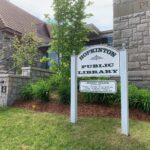The Zoning Advisory Committee at its meeting Monday night sought community feedback as the town formulates its response to the state’s MBTA Communities Act.
The state adopted the MBTA Communities Law in 2021 to spur the development of multifamily housing by right in communities served by the MBTA outside of Boston to help ease the state’s housing crisis. Hopkinton is considered to be an MBTA-adjacent community because of its proximity to the Southborough commuter rail station.
Principal Planner John Gelcich shared a presentation on the methodology behind this requirement and the implications if a community chooses not to comply with it. He noted that housing development has slowed since the 1980s and cannot accommodate the growing population. Massachusetts currently has some of the highest housing costs in the country for both sales and rentals. He also noted that metropolitan Boston has one of the lowest rates of building permit issuances in the nation.
“While there are things that we’re fighting against in Massachusetts, that doesn’t mean that we can’t build more dense housing,” he said, noting that southern states have more developable land. “It just means that we have less land to play with, compared to other states.”
Hopkinton would be required to zone for 750 housing units, a density of 15 units per acre for 50 developable acres, or 10% of the 2020 Census housing stock, whichever number is greater. The target stressed was 750 housing units. For the zoning districts to count toward the minimum land area, they have to have a minimum of 5 acres.
Although the statute doesn’t require affordable units, compliance guidelines allow districts to include an affordability component in market-rate developments. Hopkinton’s current draft bylaw states that 10% of the developments over five units must be affordable, like in the new inclusionary zoning bylaw.
“A lot of people are still viewing MBTA Communities as an option,” said Gelcich. While not technically a mandate, Attorney General Andrea Campbell made clear earlier this year that communities that do not comply will face fair housing lawsuits and will be deemed ineligible to receive 16 state grants at this time, and potentially more. On Aug. 17, the guidelines were revised to include mixed-use developments to encourage housing above street-level retail businesses.
What the MBTA Communities Act seeks to do is create what was termed as “missing middle housing.” This excludes single-family detached homes and large apartment buildings, focusing on multilevel smaller developments and townhouses. Allowing for a variety of smaller styles of development allows towns to make them “not so cookie-cutter,” according to Gelcich.
Gelcich stressed that the law does not require the units to be built. There needs to be zoning districts to accommodate them, however. They most likely would be overlay districts in Hopkinton’s case.
While the goal was to encourage public participation, Gelcich noted that mainly Hopkinton Chamber of Commerce members took part in the virtual meeting. He encouraged people to share their feedback with ZAC as the deadline to complete the proposal looms on the horizon. ZAC would need to recommend a draft to the Planning Board, and then it would be submitted to the state. The state would review the proposed bylaw before it goes to Town Meeting for a vote in May 2024. Gelcich hoped the draft could be completed by Dec. 1 to prepare it for this process. Then, more public outreach can be done to make residents aware of it.
ZAC chair Ted Barker-Hook acknowledged that the committee is “under a time crunch” to identify the land to be included in the zoning district.
Current areas identified near the train station include the Carbone’s Restaurant property and about 22 acres in the area of the Forest Lane condominiums (across from the entrance to Hopkinton State Park). This likely would mirror the adoption of zoning on the Southborough side of the commuter rail station, Gelcich said.
In addition, about 76 acres at South Street were discussed. The concern there, Gelcich said, was losing land that currently is industrially zoned. Other parcels near Interstate 495 were discussed in lesser detail. The Elmwood School and the downtown area also could potentially be included in the MBTA Communities zoning.
Former Select Board member John Coutinho noted that the Hopkinton Drug property, currently up for sale, “would be absolutely perfect to have some really great retail to go underneath with apartments above.” It would encourage pedestrian activity downtown as well.
He added that the Communities at Golden Pond assisted living facility also may fit under the criteria for the zoning. Another point he made is that empty-nesters can’t find apartments in town when they want to downsize.
Gelcich said that public opinion so far is against using the Center School property as part of this zoning district because it is being considered for other uses.
Barker-Hook noted that for this zoning district to pass at Town Meeting, it “must overcome at least two big hurdles.”
“The first is educating the people of Hopkinton that we have no choice in creating zoning for more dense housing,” he said. “The feeling in town, as we all know, is frustration with rapid overdevelopment.”
Also, he said there will be a lot of “not in my backyard” discussions about the land included. Increasing the acres would allow the housing to be less dense.
“I very much want to find ways where we can diversify our housing stock and our socioeconomic picture in town,” Barker-Hook said. “I also know the reality of that seems to get voted in and out of Town Meeting.”
Planning Board vice chair Rob Benson noted that the new housing would stress the public school system, which already has an exploding population.
The key, Barker-Hook said, is to find balance between the state’s demands and the town’s goals.





















I’m also concerned about the impact of adding 750 more housing units to our town given the tremendous cost to build schools today. While this directive says they don’t have to be built, at some point they would be — does the state provide any additional support to building schools if communities comply? Can the estimated students per unit be built into the calculations for new schools so we don’t have to keep going back to add more classrooms?
Also, it’s unclear whether we already have any of the 750 units or will they all be new?
Do we know what the financial impact would be of building these 750 units (burden on schools and town services) versus the penalty in lost grant money? Do we know the estimated number of students who could potentially inhabit these homes? Has anyone reached out to Dr. Cavanaugh to understand how the schools would deal with this potential influx of new students in terms of resources, cost, and space? Can the town of Hopkinton place an age restriction (and perhaps change our bylaw for affordable housing) on all of these units so that they are for senior citizens only (no children)? We don’t have enough police officers to keep the current citizens of Hopkinton safe let alone adding to our population. Who is ensuring that we are fiscally responsible in managing tax payer money? We need to change our town governance from volunteer boards to paid professional town management.